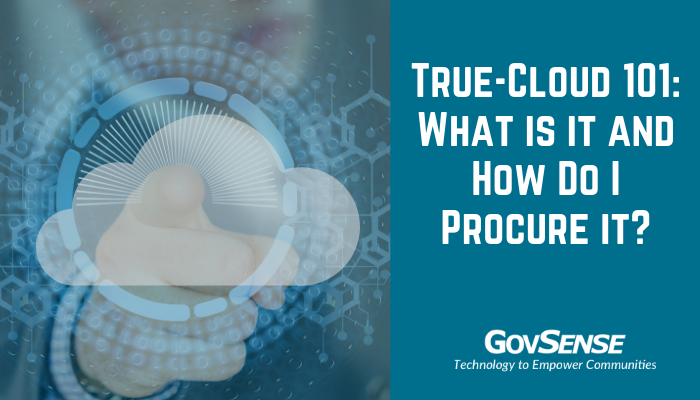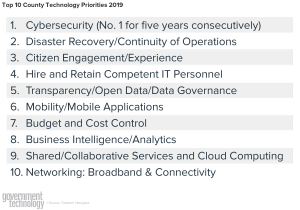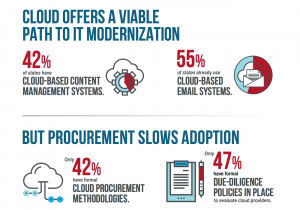Procuring for The Cloud

If you’re on the market for a new software solution, you’re fully aware of the numerous kinds of software available. The one you’re probably seeing more and more frequently these days is cloud and SaaS software – and for good reason! Though cloud software and cloud solutions have been around for almost 20 years now, public sector is now latching onto the concept.
“For many, cloud adoption is no longer an ‘if,’ it’s a ‘when.’ The benefits of the public cloud are becoming too great to ignore,” said David Smith, CEO of Teradici, in a Forbes article titled ‘Government In The Cloud: Adoption Has Become Safer And Smarter.’
So, if you want to stay ahead of the technology curve and stop operating on software created to function in 1996, let’s dive into what true-cloud software is, how it can benefit you and your jurisdiction and how to procure for it.
What is cloud software?
In the simplest of terms, it means delivering services through the internet rather than through on-premise software loaded onto your server. That means no hardware has to be installed on your personal computer to access the software. All you need is an internet connection! (Really, that’s all you need.)
Okay, I understand cloud software. What’s a SaaS software solution?
So, SaaS stands for ‘Software as a Service’, and this is a kind of cloud computing. By definition, SaaS is “a software distribution model in which a service provider hosts applications for customers and makes them available to these customers via the internet.” You probably use a SaaS application every day. Some common examples of this model are Microsoft Office 365, Dropbox, Google Drive, Eventbrite and Netflix. See? This sort of software isn’t as foreign as you might have believed! Here are the main four points you need to know about SaaS:
- The software is accessed via a web browser.
- Data is stored in a remote location.
- Updates are made remotely and automatically.
- It is subscription-based – meaning you don’t pay for one version upfront. Instead, the software is licensed on a cadence.
So, is this the same as a hosted software solution?
No. Hosted basically means you purchase and own a software version that is ‘hosted’ at a remote data center. The hosted software then has to be installed on your servers much like legacy on-premise systems. By subscribing to this sort of application that is simply hosted at another company, you experience many of the same problems and costs as if it were on-premise—only worse that access is typically slower than if you had the software installed on your own servers. And now you have even more dependence on third party IT to fix problems.
There are actually several questions you can ask yourself when trying to discern whether a software solution is true-cloud or “fake-cloud” AKA a hosted solution.
If the vendor’s answer is NO to any of these questions, scrap the launch and look for a true cloud solution.
- Do you host, maintain or manage your own solution?
- Are all of your current customers using the same version of your software?
- Are software upgrades free of charge?
- Is it true that consulting or implementation services are not required for software upgrades?
- Do you provide solutions with an open API?
- Can customers execute their own business-specific customizations within the system?
Is it really secure?
Absolutely, yes. In fact, it’s actually significantly more secure than on-premise legacy software. With the rise in cyberattacks on local governments, it’s no surprise that cybersecurity is a top priority for governments. Actually, according to a study by Government Technology, it’s been the No. 1 concern for states, cities and counties for five consecutive years.  True-cloud software providers often have extra protection for government data like continuous security monitoring of physical networks, 24-hour surveillance of data centers with managed physical access, no direct access to the database and two-factor authentication. Also, very few governments have the ability to dedicate the time, money and resources to security and maintenance as a cloud provider, so more often than not, a SaaS platform is a security upgrade.
True-cloud software providers often have extra protection for government data like continuous security monitoring of physical networks, 24-hour surveillance of data centers with managed physical access, no direct access to the database and two-factor authentication. Also, very few governments have the ability to dedicate the time, money and resources to security and maintenance as a cloud provider, so more often than not, a SaaS platform is a security upgrade.
Now that you have some background on what a true-cloud solution is and isn’t, let’s talk about the benefits for you and your jurisdiction.
- Everybody is using the same, latest version — product upgrades are fast, regular and at no additional cost. There are no compatibility issues nor hidden fees.
- You can trust the cloud — the state-of-the-art security and technical resources provided by cloud data centers are at a level no single jurisdiction can afford.
- Lowered reliance on IT – costly maintenance and support is obsolete with a cloud solution.
- No hardware needed — gone are the days of tedious, problematic and time-consuming software upgrades that often came with significant service fees from on-premise software vendors.
- Get access anywhere at any time on any device — because the software is accessed via the internet, you can work 24/7/365.
- Get a 360° view of your business — true-cloud solutions can be easily integrated with other systems, whether those systems are cloud-based or not.
- Low total cost of ownership — the multi-tenancy approach shares the common aspects of the software while only costing you for any additions necessary and specific to your needs.
- You can still make a true-cloud system your own — the flexibility to service your own application allows you to manage, maintain and configure it immediately.
- Quick Time-To-Value – Implementation is simplified. You’re up and running in weeks to months, not months to years.
How do I procure for the cloud? Ask the right questions!
A shift to the cloud is a departure from traditional purchasing processes. It is imperative that processes and policies are put into place to specifically evaluate and vet cloud software solutions.
- In cloud software solutions, hardware is not needed, so the standard data center procurement questions and requirements are no longer relevant. If you keep asking the same old questions, chances are you’ll keep receiving proposals from legacy on-premise software that you don’t want or need.
- Create more performance-based questions rather than focusing on infrastructure and hardware. Cloud solutions have established best practices for data center operations; it is not necessary to demand specific equipment and procedures.
- Make sure procurement and IT talk to each other! It’s essential to understand fundamental issues and how the new system will integrate and replace the old.
- Determine what your workload and the vendor’s workloads will look like, how much time needs to be dedicated, if prior skills are needed, etc.
- Think about pricing differently. Cloud services are procured via subscriptions. The potential benefits of this model include less upfront investment and more predictable fees. officials must look beyond first-year costs by conducting a three or five-year total cost of ownership.
- Ask about who owns the data, who has access to data, where it is stored and how it’s protected.
- This one may seem like common sense, but make sure they have experience in the public sector. Cloud software that serves commercial enterprises may not translate well to government regulations and requirements.
If you’re interested in seeing firsthand how true-cloud software can benefit your jurisdiction, click below.
GovSense is the first complete cloud solution purpose-built for local governments, empowering over 60 communities and supporting more than 2 million citizens. Govsense built on Oracle NetSuite—the #1 true cloud ERP platform with over 50,000 customers worldwide— GovSense delivers a modern, unified system that streamlines operations, enhances transparency, and drives efficiency. GovSense’s team has been implementing cloud solutions since 2005, bringing over two decades of expertise in delivering scalable and secure technology for local agencies. As a five-time GovTech 100 recipient, we are recognized as an industry leader in transforming government technology. GovSense is one modern platform that has everything you need for your local government, ensuring your community is equipped with the tools to thrive in the digital age.
